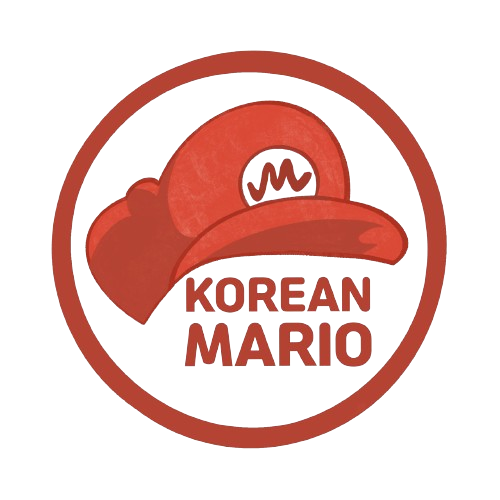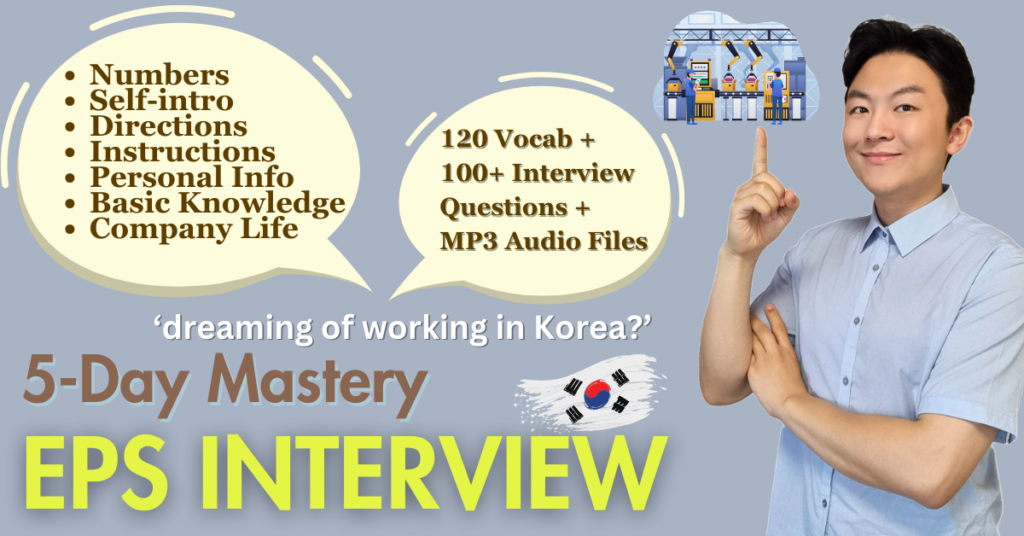
What is EPS?
EPS Go KR: Fulfill your dream of working in Korea! EPS is a system allowing Korean SMEs to legally employ foreign workers, contributing to national economic development.
Agreed upon by governments to hire foreigners from 16 countries, including:
🇵🇭 Philippines 🇲🇳 Mongolia 🇱🇰 Sri Lanka 🇻🇳 Vietnam 🇹🇭 Thailand 🇮🇩 Indonesia 🇺🇿 Uzbekistan 🇵🇰 Pakistan 🇰🇭 Cambodia 🇨🇳 China 🇧🇩 Bangladesh 🇰🇬 Kyrgyzstan 🇳🇵 Nepal 🇲🇲 Myanmar (Burma) 🇹🇱 East Timor (Timor-Leste) 🇱🇦 Laos
Applicants undergo Korean language evaluation, skill level assessment, job competency evaluation, and health check. Ultimately, successful candidates receive a work visa to enter and work in Korea.
Industries Covered
| Manufacturing | Companies with less than 300 full-time workers or less than KRW 8 billion in capital |
| Construction | Any type of construction project ※ Excluding construction companies building power plants, steelworks and petrochemical facilities holding industrial environment facilities licenses |
| Service | Construction waste management, recycled material collection and sales, warehousing and cold storage (inland), publication of books, magazines and printed materials, publication of music and audio contents |
| Fishing | Deep sea and coastal fishing, fish farming, extraction of salt |
| Agriculture and Stock-breeding | Plant cultivation, stock-breeding, and its service |
Process of EPS
Registration Process > TOPIK Test (1st round) > Skills and Competency Test (2nd round > Job Seeker’s Roster > Labor Contract > Pre-Departure Education > Visa issuance > Deployment Process > Post-Deployment
Registration process
Applicants shall register their application within the scheduled 3-day period either through manual or online procedure.
Following, corresponding test fee shall be charged per applicant payable directly to the HRD-Korea account.
EPS – Test on Proficiency in Korean (TOPIK)
The 1st round of Test (either Paper-based or Computer-based Test) wil consist of Reading and Listening modules of 25 minutes each module.
Skills and Competency Test
Only Passers from the 1st round of test wil be eligible ot take this 2nd round of test. Skills test will consist of three (3) parts, that is,
a. Physical strength Test including Ishihara Color Blind test,
b. Basic Skills Test, and
c. Interview.
Competency Test is the submission of Certificates of Employment for those who have work experiences in their chosen industries and/or a National Certificate and Diploma or completed Training Course related to their chosen industries.
Generally, ONLY passers of the 2nd round can move forward to the next step : Job Seeker’s Roster > Labor Contract > Pre-Departure Education > Visa issuance > Deployment Process > Post-Deployment
| 1st round: EPS-TOPIK | ||
|---|---|---|
| Test Section | Listening & reading(25 questions each) | |
| Multiple choice (4 options) | ||
| ★Caution★ Passing is a basic requirement of employment in Korea but it does not guarantee employment | ||
| Pass Criterion | Among scorers above the lowest standard by industry, successful candidates are determined in the order of grades up to the expected number. | |
| 2nd round: Skills Test | ||
|---|---|---|
| Test Section | Physical fitness, interview, basic job performance skills | |
| Application | The examination result is provided to the employer as basic data along with the interview video and other relevant information. | |
What is EPS-TOPIK? (1st round)
The EPS-TOPIK Test, also known as KLT, is conducted by the Ministry of Employment and Labor of South Korea. This test is designed for the selection of foreign workers to engage in various sectors such as manufacturing units, construction sites, agriculture, and more. In essence, it evaluates the language proficiency of potential foreign employees, ensuring their capability to perform job responsibilities efficiently and navigate daily life without language barriers.
Furthermore, the EPS-TOPIK score plays a crucial role as it determines the eligibility of foreign job seekers. Subsequently, those who qualify based on their scores can proceed to apply for jobs and secure the necessary working visa (E-9).
Who conducts the test?
The Human Resources Development Service of South Korea administers the test.
The HRD Korea operates under South Korea’s Ministry of Employment and Labor.
Additionally, they collaborate with various governments to facilitate the organization of the test.
What is the Eligibility for EPS TOPIK?
- Person should be aged between 18 and 39
- Person should not have any criminal record in relation to serious offence punishable by imprisonment
- Person should not have any past records of deportation or departure under a departure order from the Republic of Korea
- Person should not be subject to travel ban in his/her home country
- Person should fulfil the eligibility requirements decided by both countries
Overview of the EPS TOPIK
Test structure
This is a single-level exam. There are two sections:
- Listening: 20 questions — 100 points, 25 minutes.
- Reading: 20 questions — 100 points, 25 minutes
The total number of questions is 40, and the duration is 50 minutes. There is no break between these two modules.
Candidates can choose between two methods:
- PBT (Paper-Based Test), and
- CBT (Computer-Based Test).
All questions are MCQ (Multiple-Choice Questions), and you have to pick one correct answer out of 4 choices.
To pass, candidates need at least 80 out of 200 marks. They also maintain a list that has the highest score from the top. However, the final selection depends on the other eligibility criteria and the total number of applicants. HRD Korea decides this.
Crucially, the ‘EPS-TOPIK’ test focuses on fundamental grammar and vocabulary. Ensure you invest time to extensive reading and the memorization of a broader range of vocabulary. Visit our mainpage and register to claim free learning materials.
How to apply?
There are two ways to register for the test — offline and online.
Addition, you can visit the approved place. Fill out the form, choose the dates and test center, and submit the registration fee.
You can register online on the HRD Korea government website when dates are available. This is the simplest way.
Fill out the form with personal details and things related to this test. Additionally, attach a scanned copy of your passport and a photo. Conclude the process by submitting the form and making the necessary payment.
Validity
The score is valid for only two years from the date of test result announcements. Once the actual term expires, one has to retake to apply for EPS jobs in Korea.
Testing Centers Across The World
The testing centers depend on the MoU between the two countries.
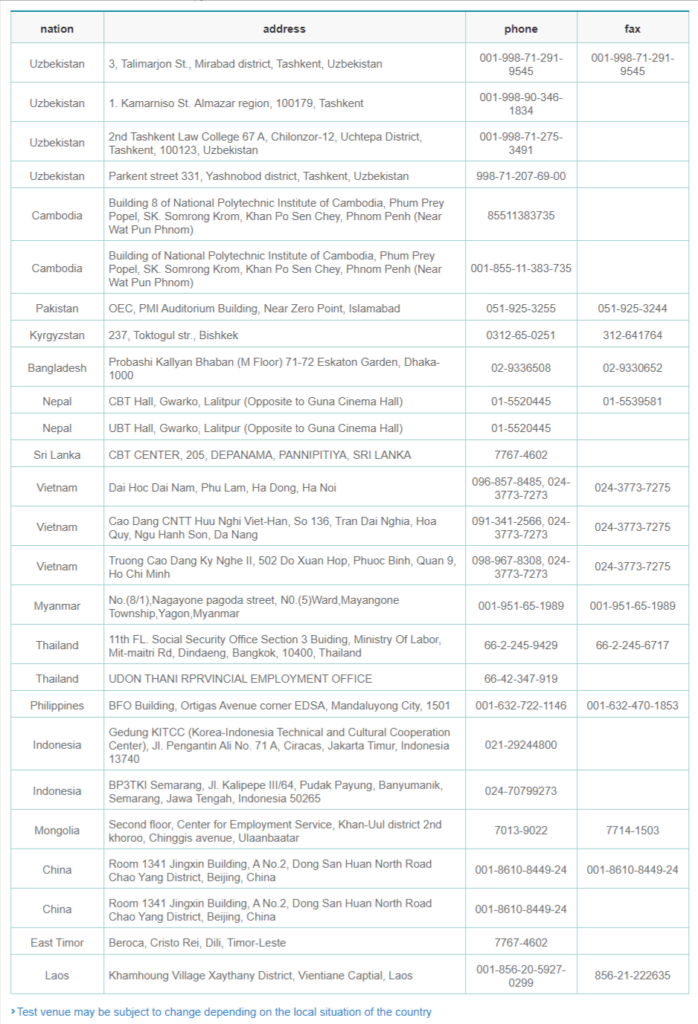
However, if your country is not on the list, there is no arrangement, and you’re not eligible to appear for the test
EPS TOPIK 2024 Dates
They conduct the test once a year. The EPS TOPIK test dates and timing vary depending on the test centers. They often declare the result within 2-4 weeks.
Also, you can get in touch with the respective center for more details.
Due to various reasons, there is a possibility of the upcoming test being postponed or canceled. Therefore, it is advisable to contact them directly or visit their official website for the latest updates.
The Examination Fee
The exam fee varies depending on the country, with costs typically ranging between $20 and $40.
How To Prepare
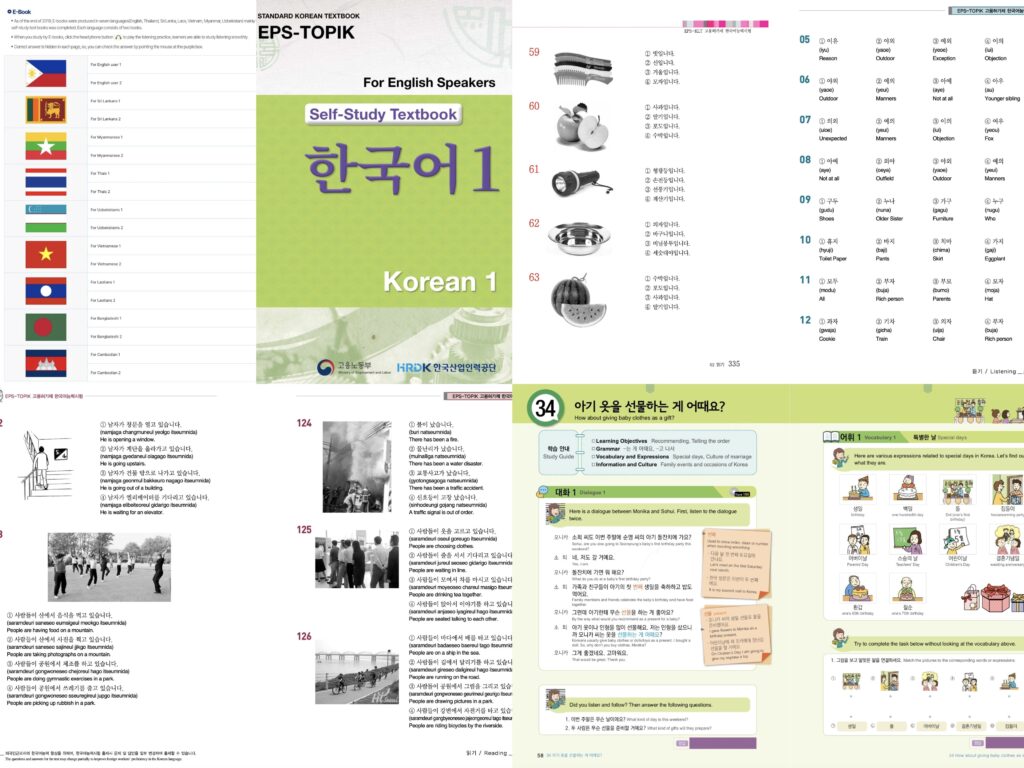
HRD Korea Textbook in 7 Languages (FREE)
Most importantly, the HRD Korea has published a book mainly for EPS TOPIK in 7 languages. It covers the syllabus, from basic Korean language skills and work-related content too. Click to access to the textbook FOR FREE.
E-books are produced in 7 languages (English, Thailand, Sri Lanka, Laos, Vietnam, Myanmar, Uzbekistan). Moreover, each language consists of 2 books.
When you study by e-books, click the headphone button 🎧 to play the listening practice, learners are able to study listening smoothly.
Correct answer is hidden in each page, so, you can check the answer by pointing the mouse at the purple box.
Reading and Listening Practice Book (FREE)
What is included in the download?
– 2 Reading Practice Textbooks (1440 Questions)
– 2 Reading Practice Answer Book
– 2 Listening Practice Textbooks (1920 Questions)
– 2 Reading Practice Answer Book
– MP3 Audio Files
– 8 Special EPS Textbooks and 1 Answer Book
Click here to download the Reading and Listening Question Books along with their corresponding answers published by HRD Korea here.
Only Passers from the 1st round of test will be eligible to take this 2nd round of test.

To master the most essential grammar rules and learn 300 vocabulary words in just 10 days, learn with Mario at only $8.99. Click here for more!
EPS Interview (2nd round)
Firstly, thank you for visiting my blog. While browsing various websites, I noticed the lack of comprehensive details for the EPS interview. In response, I have created a free course to guide you and streamline your job application process.
Furthermore, be sure to watch five videos and review the question banks provided below; this constitutes the most complete guide you need to prepare thoroughly for the interview.
Interview Procedures and Methods
STEP 1: Candidates wait in the waiting room and enter one by one for the interview.
STEP 2: Conducted only in Korean, within 4 minutes, with video recording.
STEP 3: Interviewee stands at a designated spot, introduces themselves, and answers the interviewer’s questions.
STEP 4: Evaluation covers self-introduction, basic personal information, knowledge, and job-related skills.
Number Practice
| NO | SINO | NATIVE | NO | SINO | NATIVE | NO | SINO | NATIVE | NO | SINO | NATIVE |
| 1 | 일 | 하나(한) | 26 | 이십육 | 스물여섯 | 51 | 오십일 | 쉰하나 | 76 | 칠십육 | 일흔여섯 |
| 2 | 이 | 둘(두) | 27 | 이십칠 | 스물일곱 | 52 | 오십이 | 쉰둘 | 77 | 칠십칠 | 일흔일곱 |
| 3 | 삼 | 셋(세) | 28 | 이십팔 | 스물여덟 | 53 | 오십삼 | 쉰셋 | 78 | 칠십팔 | 일흔여덟 |
| 4 | 사 | 넷(네) | 29 | 이십구 | 스물아홉 | 54 | 오십사 | 쉰넷 | 79 | 칠십구 | 일흔아홉 |
| 5 | 오 | 다섯 | 30 | 삼십 | 서른 | 55 | 오십오 | 쉰다섯 | 80 | 팔십 | 여든 |
| 6 | 육 | 여섯 | 31 | 삼십일 | 서른하나 | 56 | 오십육 | 쉰여섯 | 81 | 팔십일 | 여든하나 |
| 7 | 칠 | 일곱 | 32 | 삼십이 | 서른둘 | 57 | 오십칠 | 쉰일곱 | 82 | 팔십이 | 여든둘 |
| 8 | 팔 | 여덟 | 33 | 삼십삼 | 서른셋 | 58 | 오십팔 | 쉰여덟 | 83 | 팔십삼 | 여든셋 |
| 9 | 구 | 아홉 | 34 | 삼십사 | 서른넷 | 59 | 오십구 | 쉰아홉 | 84 | 팔십사 | 여든넷 |
| 10 | 십 | 열 | 35 | 삼십오 | 서른다섯 | 60 | 육십 | 예순 | 85 | 팔십오 | 여든다섯 |
| 11 | 십일 | 열하나 | 36 | 삼십육 | 서른여섯 | 61 | 육십일 | 예순하나 | 86 | 팔십육 | 여든여섯 |
| 12 | 십이 | 열둘 | 37 | 삼십칠 | 서른일곱 | 62 | 육십이 | 예순둘 | 87 | 팔십칠 | 여든일곱 |
| 13 | 십삼 | 열셋 | 38 | 삼십팔 | 서른여덟 | 63 | 육십삼 | 예순셋 | 88 | 팔십팔 | 여든여덟 |
| 14 | 십사 | 열넷 | 39 | 삼십구 | 서른아홉 | 64 | 육십사 | 예순넷 | 89 | 팔십구 | 여든아홉 |
| 15 | 십오 | 열다섯 | 40 | 사십 | 마흔 | 65 | 육십오 | 예순다섯 | 90 | 구십 | 아흔 |
| 16 | 십육 | 열여섯 | 41 | 사십일 | 마흔하나 | 66 | 육십육 | 예순여섯 | 91 | 구십일 | 아흔하나 |
| 17 | 십칠 | 열일곱 | 42 | 사십이 | 마흔둘 | 67 | 육십칠 | 예순일곱 | 92 | 구십이 | 아흔둘 |
| 18 | 십팔 | 열여덟 | 43 | 사십삼 | 마흔셋 | 68 | 육십팔 | 예순여덟 | 93 | 구십삼 | 아흔셋 |
| 19 | 십구 | 열아홉 | 44 | 사십사 | 마흔넷 | 69 | 육십구 | 예순아홉 | 94 | 구십사 | 아흔넷 |
| 20 | 이십 | 스물 | 45 | 사십오 | 마흔다섯 | 70 | 칠십 | 일흔 | 95 | 구십오 | 아흔다섯 |
| 21 | 이십일 | 스물하나 | 46 | 사십육 | 마흔여섯 | 71 | 칠십일 | 일흔하나 | 96 | 구십육 | 아흔여섯 |
| 22 | 이십이 | 스물둘 | 47 | 사십칠 | 마흔일곱 | 72 | 칠십이 | 일흔둘 | 97 | 구십칠 | 아흔일곱 |
| 23 | 이십삼 | 스물셋 | 48 | 사십팔 | 마흔여덟 | 73 | 칠십삼 | 일흔셋 | 98 | 구십팔 | 아흔여덟 |
| 24 | 이십사 | 스물넷 | 49 | 사십구 | 마흔아홉 | 74 | 칠십사 | 일흔넷 | 99 | 구십구 | 아흔아홉 |
| 25 | 이십오 | 스물다섯 | 50 | 오십 | 쉰 | 75 | 칠십오 | 일흔다섯 | 100 | 백 | 백 |
Sino Numbers
| 8 | 19 | 25 | 48 | 56 | 72 | 93 | 100 |
| 팔 | 십구 | 이십오 | 사십팔 | 오십육 | 칠십이 | 구십삼 | 백 |
Native Numbers
| 2 | 5 | 7 | 8 | 18 | 25 | 46 | 47 |
| 이 | 오 | 칠 | 팔 | 십팔 | 이십오 | 삼십육 | 사십칠 |
Time
| 01:00 | 06:35 | 07:42 | 11:14 | 12.30 |
| 한시 | 여섯시 삼십오분 | 일곱시 사십이분 | 열한시 십사분 | 열두시 삼십분 |
| 02:27 | 04:28 | 08:31 | 10:06 | 05:59 |
| 두시 이십칠분 | 네시 이십팔분 | 여덟시 삼십일분 | 열시 육분 | 다섯시 오십구분 |
Date
| 1991 – 11 – 07 | 천구백구십일년 십일월 칠일 |
| 1996 – 03 – 31 | 천구백구십육년 삼월 삼십일일 |
| 2023 – 12 – 22 | 이천이십삼년 십이월 이십이일 |
| 4월 2일 | 사월 이일 |
| 5월 19일 | 오월 십구일 |
| 7월 28일 | 칠월 이십팔일 |
| 6월 30일 | 유월 삼십일 |
Video Tutorial (FREE)
Introduction (EP1)
Self Introduction (EP2)
Firstly, when it’s your turn to wait in the waiting room, they say, “다음 분 들어오세요(Next person, come in).”
Then you go in, stand on the ground, say “안녕하십니까(Hello)” and bow down.
The interviewer says, “자기소개 해보세요(Introduce yourself).”
Then, start introducing yourself.
You should say it clearly and confidently in a loud voice.
If you practice hard, you will memorize everything, so try your best.
Vocab
| 이름 name | 형/오빠 older brother | 아들 son | 한국어 Korean language |
| 결혼 marriage | 남동생 younger brother | 딸 daughter | 일 work |
| 가족 family | 여동생 younger sister | 고향 hometown | 직업 job |
| 어머니 mother | 할머니 grandmother | 아내 wife | 건강 health |
| 아버지 father | 할아버지 grandfather | 졸업 graduation | 경험 experience |
| 누나/언니 older sister | 아이 kids | 한국 Korea | 열심히 work hard |
Practice Self-Introduction
저는 마리오라고 합니다.
[joneun mario rago hamnida]
My name is Mario.
저는 방글라데시에서 왔습니다.
[joneun banggeulradesi eso watsseumnida]
I’m from Bangladesh.
저는 서른두 살입니다.
[joneun soreundu sarimnida]
I’m 32 years old.
제 고향은 다카입니다.
[gohyangeun dakaimnida]
My hometown is Dhaka.
결혼했습니다 / 결혼 안 했습니다.
[gyolhonhaetsseumnida / gyolhon an haetsseumnidaa]
I’m married. / I’m not married.
가족은 어머니와 아내, 아들 하나 있습니다.
[gajogeun omoniwa adeul hana ddal hana itsseumnida]
I have a mother, a wife, and a son in my family.
한국식당에서 2년동안 일했습니다.
[hangukssikdangesoeso inyondongan ilhaetsseumnida]
I have worked at a Korean restaurant for two years.
가족들을 위해 한국에서 일하고 싶습니다.
[gajokdeureul wihae hangugeso ilhago sipsseumnida]
I want to work in Korea for my family.
한국어를 열심히 공부하고 있습니다.
[hangugeoreul yolssimhi gongbuhago issumnida]
I am studying Korean hard.
최선을 다해 열심히 일하겠습니다.
[chwesoneul dahae yolssimhi ilhagetsseumnida]
I will do my best to work hard.
Directions and Instructions (EP3)
Secondly, they give directions and instructions as soon as you finish introducing yourselves.
Next, directions are asked to evaluate whether or not you can understand your supervisor’s instructions well when you are working in Korea.
Moreover, they only ask about 20 fixed sentences, so you can understand every word by practicing hard.
Lastly, memorize all the words and sentences related to the direction. And memorize all the questions, too.
Vocab
| 오른쪽 right side | 옆 beside | 보세요 look | 일어나세요 stand up |
| 왼쪽 left side | 오른손 right hand | 가세요 go | 돌아보세요 look back |
| 위 up/top | 왼손 left hand | 오세요 come | 이쪽 this side |
| 아래 down/below | 양손 both hands | 멈추세요 stop | 그쪽 that side |
| 앞 front | 올리세요 raise | 의자 chair | 여기 here |
| 뒤 behind | 내리세요 put down | 앉으세요 sit down | 거기 there |
Instructions 1:
위로 보세요.
[wiro boseyo]
Look up.
아래로 보세요.
[araero boseyo]
Look down.
오른쪽으로 보세요.
[oreunjjogeuro boseyo]
Look right.
왼쪽으로 보세요.
[waenjjogeuro boseyo]
Look left.
앞으로 보세요.
[apeuro boseyo]
Look front.
뒤로 보세요.
[dwiro boseyo]
Look behind.
왼손 올리세요. / 왼손 내리세요.
[wenson olriseyo] / [wenson naeriseyo]
Raise left hand. / Put your left hand down.
오른손 올리세요. / 오른손 내리세요
[oreunson olriseyo] / [oreunson naeriseyo]
Raise right hand. / Put your right hand down.
양손 올리세요.
[yangson olriseyo]
Raise both your hands.
양손 내리세요.
[yangson naeriseyo]
Put your both hands down.
왼쪽으로 가세요.
[waenjjogeuro gaseyo]
Go to the left.
오른쪽으로 가세요.
[oreunjjogeuro gaseyo]
Go to the right.
이쪽으로 오세요.
[ijjogeuro oseyo]
Come here.
뒤로 가세요.
[dwiro gaseyo]
Go to the back.
멈추세요.
[momchuseyo]
Stop.
뒤로 돌아보세요.
[dwiro doraboseyo]
Turn back.
앞으로 돌아보세요.
[apeuro doraboseyo]
Turn forward.
의자에 앉으세요.
[uijae anjeuseyo]
Have a seat on the chair.
Personal Information (EP4)
Thirdly, after orientation, the interviewer asks the interviewee to sit down on a chair and asks about personal information.
They usually ask about family relationships or hobbies.
Then, they ask simple questions that are not too difficult.
Listen to the audio files from this book, practice a lot so that you can answer them at the interview.
However, if you didn’t hear the question clearly, ask, “죄송하지만 다시한번 말해주시겠습니까? (I’m sorry, but could you say it again?)”
And, if you didn’t understand the question, politely say, “죄송하지만 질문을 이해하지 못했습니다. (I’m sorry, but I didn’t understand it.)”
Vocab
| 생년월일 birth date | 오늘 today | 부모님 parents | 영화 movie |
| 년 year | 어제 yesterday | 있어요 to have | 색깔 color |
| 월 month | 내일 tomorrow | 없어요 don’t have | 몸무게 weight |
| 일 day | 몇 월 what month | 계절 seasons | 키 height |
| 학원 academy | 며칠 what date | 취미 hobby | 얼마 how many |
| 독학 self-study | 배우다 to learn | 운동 exercise | 언제 when |
Question Bank 1
Q: 이름이 뭐예요? / 성함이 어떻게 되세요?
[ireumi mwoeyo/songhami ottoke dweseyo]
What’s your name?
A: 마리오입니다.
[marioimnida]
I’m Mario.
Q: 키가 몇 센티미터 입니까?
[kiga myot sentimito imnikka]
How tall are you?
A: 175cm입니다.
[baekchilsibo sentimito imnida]
My height is 175cm
Q: 가족이 몇 명입니까?
[gajogi myot myongimnikka]
How many family members do you have?
A: 다섯명입니다.
[dasonmyongimnida]
There are five people in my family.
Q: 한국어는 어디에서 배웠어요?
[hangugoneun odieso baewossoyo]
Where did you learn Korean?
A: 한국어 학원에서 배웠습니다.
[hangugo hagwoneso baewotsseumnida]
I learned it at a Korean language academy.
Q: 어디에서 왔어요?
[odieso wassoyo]
Where are you from?
A: 자카르타에서 왔습니다.
[jakareutaeso watsseumnida]
I’m from Jakarta.
Question Bank 2
Q: 몸무게가 얼마나 나갑니까?
[mommugega olmana nagamnikka]
How much do you weight?
A: 70Kg입니다.
[chilsip kilrogram imnida]
I weigh 70kg.
Q: 결혼했어요?
[gyolhonhaessoyo]
Are you married?
A: 네 했습니다. / 아니요, 아직 안 했습니다.
[ne haetsseumnida / aniyo ajik an haetsseumnida]
Yes, I’m married. / No, I’m not married yet.
Q: 한국어 얼마동안 배웠어요?
[hangugo olmadongan baewossoyo]
How long have you learned Korean?
A: 6개월동안 배웠습니다
[yukkkaewoldongan baewotsseumnida]
I learned it for 6 months.
Q: 생년월일이 언제예요?
[saengnyonworiri onjeeyo]
When is your birth date?
A: 1996년 3월 31일입니다.
[chongubaekkkusibyungnyon samwol samsibir irimnida]
It’s March 31, 1996.
Q: 생일이 언제예요? / 언제 태어났어요?
[saengiri onjeeyo / onje taeonassoyo]
When is your birthday? / When were you born?
A: 3월 31일입니다.
[samwol samsibir irimnida]
It’s March 31st.
Question Bank 3
Q: 부모님이 계세요?
[bumonnimi gyeseyo]
Are your parents alive?
A: 네, 부모님이 계십니다.
[ne bumonnimi gyesimnida]
Yes, my parents are alive.
Q: 취미가 뭐예요?
[chwimiga mwoeyo]
What’s your hobby?
A: 제 취미는 운동입니다.
[je chwimineun undongimnida]
My hobby is exercising.
Q: 무슨 운동을 좋아하세요?
[museun undongeul joahaseyo]
What kind of exercise do you like?
A: 배드민턴을 좋아합니다.
[baedeumintoneul joahamnida]
I like badminton.
Q: 무슨 계절을 좋아합니까?
[museun gyejoreul joahamnikka]
What season do you like?
A: 여름을 좋아합니다.
[yoreumeul joahamnida]
I like summer.
Q: 무슨 색깔을 좋아하세요?
[museun saekkkareul joahaseyo]
What color do you like?
A: 파란색을 좋아합니다.
[paransaegeul joahamnida]
I like blue.
Basic Knowledge (EP5)
Next, you will be asked common sense that everyone knows to determine if there will be any problems with your work life.
There are no complicated questions, so you can answer everything if you memorize Korean words well. Focus on memorizing words, listen to many examples of the book, and memorize everything.
In addition, it is important to learn numbers perfectly because you can also have numbers or calculation questions.
Vocab
| 왜 why | 농업 agriculture | 오후 PM | 흐리다 cloudy |
| 돈을 벌다 earn money | 어업 fishing industry | 시 hour | 비가 오다 rainy |
| 행복하다 happy | 몸 body | 분 minute | 더하기 plus |
| 제조 manufacturing | 아프다 sick | 몇시 what time | 빼기 minus |
| 건설 construction | 병원 hospital | 날씨 weather | 곱하기 multiply |
| 서비스 service | 오전 AM | 맑다 sunny | 나누기 division |
Question Bank 1
Q:몸이 아프면 어디에 가야합니까?
[momi apeumyon odie gayahamnikka]
Where should you go if you are sick?
A: 병원에 가야합니다.
[byongwone gayahamnida]
I have to go to the hospital.
Q: 지금은 몇 시입니까?
[jigeumeun myot siimnikka]
What time is it now?
A: 오전 10시 25분입니다.
[ojon yolssi isibobunimnida]
It’s 10:25 a.m.
Q: 오늘은 무슨요일이에요?
[oneureun museunnyoirieyo]
What day is it today?
A: 월요일입니다.
[woryoirimnida]
It’s Monday.
Q: 오늘은 (몇 월) 며칠입니까?
[oneureun (myot wol) myochirimnikka]
What day is it today?
A: 12월 31일입니다.
[sibiwol samsibiririmnida]
It’s December 31st.
Q: 오늘 날씨가 어떻습니까?
[oneul nalssiga ottosseumnikka]
What’s the weather like today?
A: 맑습니다.
[maksseumnida]
It’s sunny.
Question Bank 2
Q: 30 빼기 20은 무엇입니까?
[samsip ppaegi isibeun muosimnikka]
What is 30 minus 20?
A: 10입니다.
[sibimnida]
It’s 10.
Q: 4곱하기 5는 얼마입니까?
[sagopagi oneun olmaimnikka]
How much is four times five?
A: 20입니다.
[isibimnida]
It’s 20
Q: 9나누기 3은 얼마입니까?
[gunanugi samun olmaimnikka]
How much is 9 divided 3?
A: 3입니다.
[samimnida]
It’s three.
Q: (13)이 숫자가 얼마입니까?
[i sujjaga olmaimnikka]
(13) What is this number?
A: 13입니다.
[sipssamimnida]
It’s 13.
Q: (56)이 숫자가 얼마입니까?
[i sujjaga olmaimnikka]
(56) What is this number?
A: 56입니다.
[osibyugimnida]
It’s 56.
Q: (98)이 숫자가 얼마입니까?
[i sujjaga olmaimnikka]
(98) What is this number?
A: 98입니다.
[gusipparimnida]
It’s 98.
Company Life and Work (EP 6)
Let’s test whether you can handle corporate life well. You will be asked about how well you can navigate urgent situations and interact smoothly with colleagues and superiors. You will be asked about how you handle emergency situations too.
These questions are not too difficult or complex. So, if you can memorize example sentences from this book perfectly, you will be able to pass the interview eventually.
Vocab
| 직장 workplace | 배려하다 considerate | 반대 disagree | 찾다 to find |
| 동료 colleague | 사이 좋다 get along with | 근무 work | 기계 machine |
| 바쁘다 busy | 상사 supervisor | 보고하다 report | 수리 repair |
| 빨리 quickly | 사장님 boss | 실수 mistake | 불량품 defective product |
| 끝내다 finish | 방침 policy | 해결하다 slove | 불이 나다 a fire breaks out |
| 잔업 overtime work | 의견 opinion | 방법 way, method | 경제 economy |
Question Bank 1
Q: 직장동료가 바쁘면 어떻게 할 거예요?
[jikjjangdongnyoga bappeumyon ottoke hal kkoeyo]
What would you do if your colleague is busy?
A: 제가 하는 일을 빨리 끝내고 도와주겠습니다.
[jega haneun ireul ppalri kkeunnaego dowajugetsseumnida]
I’ll finish what I’m doing quickly and help my colleague.
Q: 직장 동료하고 어떻게 지낼 거예요?
[jikjjang dongnyohago ottoke jinael kkoeyo]
How are you going to get along with your colleagues?
A: 배려하면서 사이 좋게 지내겠습니다.
[baeryohamyonso sai joke jinaegetsseumnida]
I will be considerate of my colleagues and get along well.
Q: 회사 일이 많으면 어떻게 할 거예요?
[hwesa iri maneumyon ottoke hal kkoeyo]
What are you going to do if you have a lot of work?
A: 일을 다 끝낼 때까지 잔업하겠습니다.
[ireul da ggeunnael ddaeggaji janeobhagessumnida]
I’ll work overtime until I’m done.
Question Bank 2
Q: 상사가 내 의견에 반대하면 어떻게 할 거예요?
[sangsaga nae uigyone bandaehamyon ottoke hal kkoeyo]
What will you do if your supervisor disagrees with you?
A: 사장님의 지시나 회사 방침에 따르겠습니다.
[sajangnime jisina hwesa bangchime ttareugetsseumnida]
I will follow the boss’s instructions or company policy.
Q: 일을 하다가 실수하면 어떻게 할 거예요?
[ireul hadaga silssuhamyon ottoke hal kkoeyo]
What will you do if you make a mistake while working?
A: 상사에게 보고하고 다시 실수 하지 않게 노력하겠습니다.
[sangsaege bogohago dasi silssu haji anke noryokagetsseumnida]
I’ll report it to my supervisor and try not to make the mistake again.
Q: 불량품이 있으면 어떻게 할 거예요?
[bulryangpumi isseumyon ottoke hal kkoeyo]
What will you do if there is a defective product?
A: 상사에게 보고하고 해결 방법을 찾겠습니다.
[sangsaege bogohago haegyol bangbobeul chatggessummida]
I’m gonna report it to my supervisor and find a solution.
Q: 작업 하다가 사고가 나면 어떻게 할 거예요?
[jagop hadaga sagoga namyon ottoke hal kkoeyo]
What are you going to do if you get into an accident while working?
A: 큰 소리로 옆의 동료를 부르겠습니다.
[keun soriro yope dongnyoreul bureugetsseumnida]
I’ll call my colleague next to me out loud.
Question Bank 3
Q: 기계에 문제가 생기면 어떻게 할 거예요?
[gigyee munjega saenggimyon ottoke hal kkoeyo]
What will you do if there is a problem with the machine?
A: 상사에게 보고하고 수리 요청하겠습니다.
[sangsaege bogohago suri yochonghagetsseumnida]
I’ll report it to my supervisor and ask for a repair.
Q: 회사에는 몇시까지 도착할 거예요?
[hwesaeneun myotssikkaji dochakal kkoeyo]
What time will you arrive at work by?
A: 근무시간 30분 전까지 도착하겠습니다.
[geunmusigan samsipppun jonkkaji dochakagetsseumnida]
I’ll be there 30 minutes before work hours.
Q: 공장에 불이 나면 어떻게 할 거예요?
[gongjange buri namyon ottoke hal kkoeyo]
What are you going to do if there’s a fire in the factory?
A: 119에 신고하겠습니다.
[ililkue singohagetsseumnida]
I’ll call 119.
Q: 한국에 대해 아는게 있어요?
[hanguge daehae aneunge isseoyo?]
Do you know anything about Korea?
A: 한국은 작은 나라지만 짧은 시간에 크게 경제 발전을 한 나라라고 들었습니다.
[hangugeun jageun nalajiman jjalbeun sigane keuge gyeongje baljeoneul han nalarago deurossumnida]
Although Korea is a small country, it has developed greatly in a short time.
Conclusion
Finally, the concluding step after the interview holds significance. When the interview concludes, the interviewer typically expresses gratitude by saying, “Thank you for your efforts” or ‘수고했어요’. In response, the interviewee should reply with “Thank you” or ‘수고하셨습니다’ and promptly exit without displaying hesitation. Following this, a slight bow is appropriate as a gesture of respect. This practice reflects cultural manners in Korea.
This covers information about the EPS, and updates will be made regularly to reflect the latest changes. Thank you.
Learn Korean With More Blogs
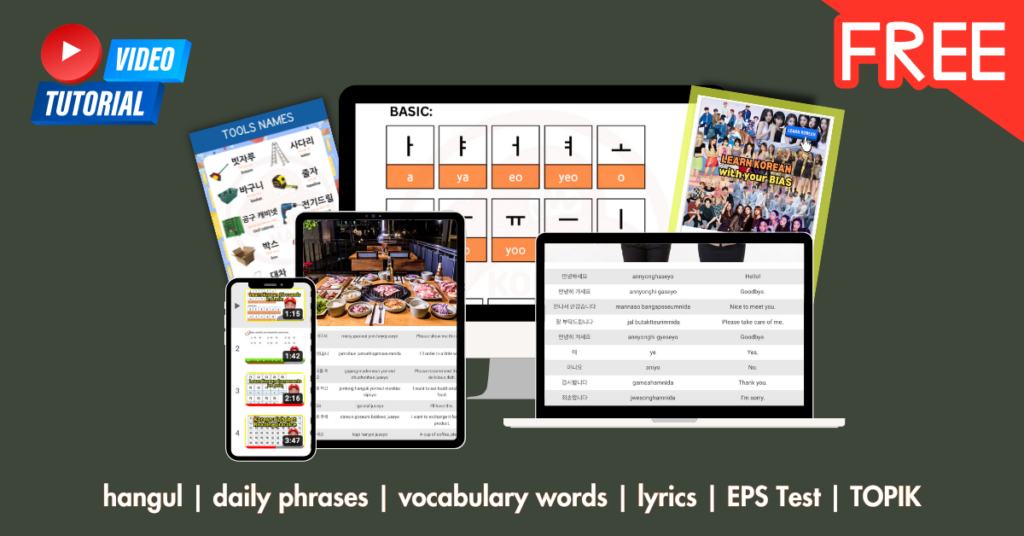
- EPS Free Course
- Learn with BTS
- Numbers and Words
- Travel and Daily Korean
- TOPIK
- Hangul – The Korean Alphabets
- Beginner Grammar
- Intermediate Grammar
- Tools Names
Table of Contents

